Tips for Lawn Care for Pet Owners
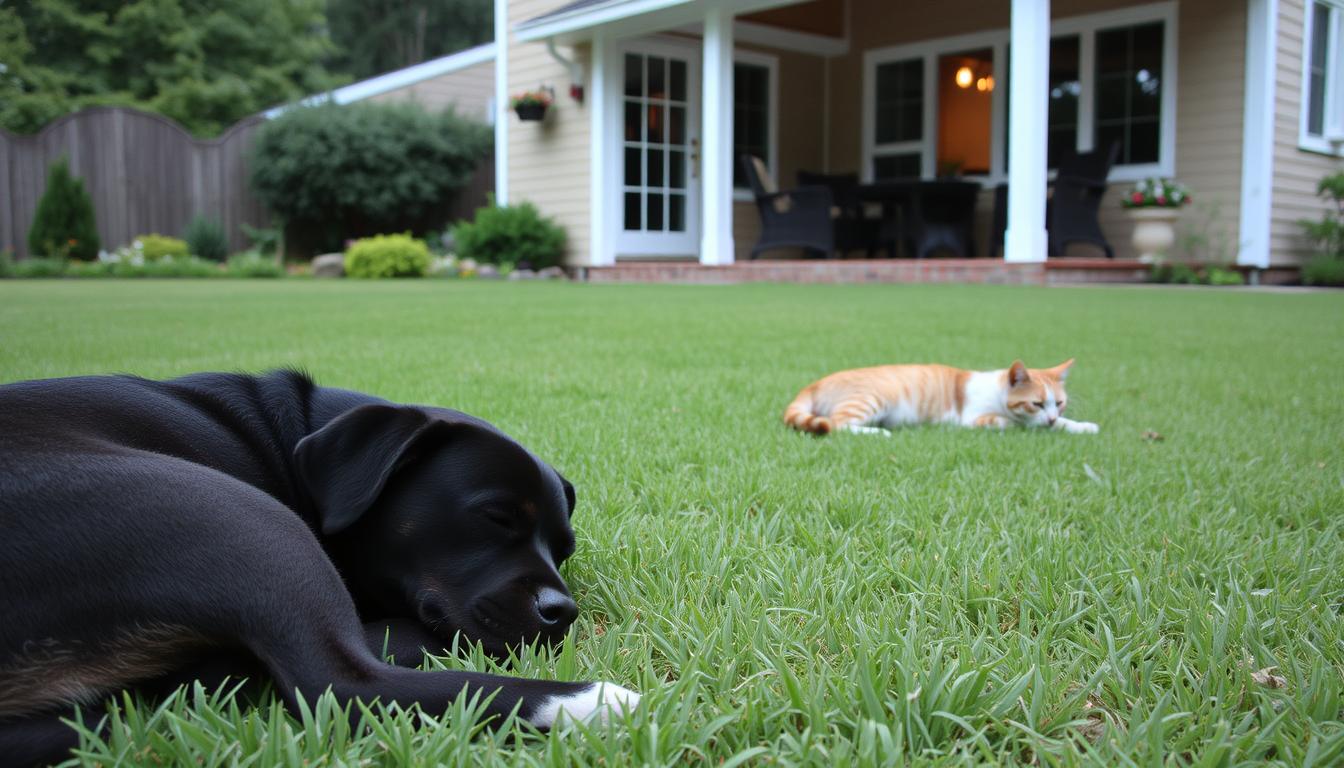
Did you know a lawnmower pollutes as much in one hour as driving a car for 350 miles? A green lawn can make your home look great, but it’s hard to keep it up, even more so with pets. Pet owners face special challenges, from pet damage to waste issues. But, with the right steps, you can have a beautiful yard and keep your pets safe and happy.
In this guide, I’ll share tips for pet owners to manage lawn care. We’ll talk about picking tough grass and handling pet waste. You’ll learn how to make your backyard a pet-friendly paradise.
Key Takeaways for Lawn Care for Pet Owners
- Choose grass varieties that are resistant to damage from pet activity, such as tall fescue, Kentucky bluegrass, and bermudagrass.
- Promptly clean up pet waste and dilute areas where dogs urinate to prevent nitrogen damage to your lawn.
- Maintain optimal mowing height to promote deeper roots and better camouflage of any damaged areas.
- Be mindful when fertilizing, as excessive nitrogen can contribute to grass burn in combination with pet waste.
- Identify and treat yellow spots early, as they may indicate urine damage that can be reversed with proper care.
Reseed Lawn with Resistant Grass Types
Keeping a lush lawn as a pet owner can be tough. Dog urine spots and bare patches often show a weak grass type. Think about switching to dog-friendly grass types that handle pet activity better. Some good options include:
- Tall fescue – A cool-season grass that can handle some foot traffic and drought, but needs regular mowing.
- Kentucky bluegrass – A cool-season grass that’s okay with some foot traffic, spreads on its own to fix bare spots.
- Perennial ryegrass – A cool-season grass that’s very tough but can get sick easily.
- Bermudagrass – A warm-season grass that’s great for foot traffic and drought.
- Zoysiagrass – A warm-season grass that’s dark green, dense, and good at fighting pet damage, also keeps the soil cool.
If you can’t replace your lawn, reseeding or laying new sod in dog spots can help. This makes your lawn stronger and more dog-friendly.
| Grass Type | Foot Traffic Tolerance | Mowing Frequency | Disease Resistance |
|---|---|---|---|
| Tall Fescue | Moderate | Frequent | Tolerant |
| Kentucky Bluegrass | Low to Moderate | Moderate | Moderate to High |
| Perennial Ryegrass | High | Moderate | High |
| Bermudagrass | High | Frequent | Good |
| Zoysiagrass | High | Low | Good |
“Kentucky Bluegrass forms a dense turf that can withstand heavy foot traffic and pet activity while maintaining its attractive appearance.”
By choosing lawn grass resistant to pet damage and tough grass for high-traffic areas, you can make a resilient turf for pet owners. This turf can handle the demands of having a furry friend.
Deal with Pet Waste Promptly
As a pet owner, I understand the need to manage dog waste on the lawn. Dog poop and urine can harm the grass if not cleaned up. Dog waste has a lot of nitrogen, which can turn your lawn brown or dark green.
To avoid this, I clean up dog poop right away. I also water the spot where my dog urinates with a hose. This helps dilute the urine and protect the grass.
Choosing the right pet food is also key. A lower protein diet can reduce nitrogen in my dog’s urine. This helps prevent damage to the lawn.
By cleaning up, diluting, and choosing the right food, my lawn stays healthy. It’s a small effort that keeps my outdoor space beautiful for everyone.
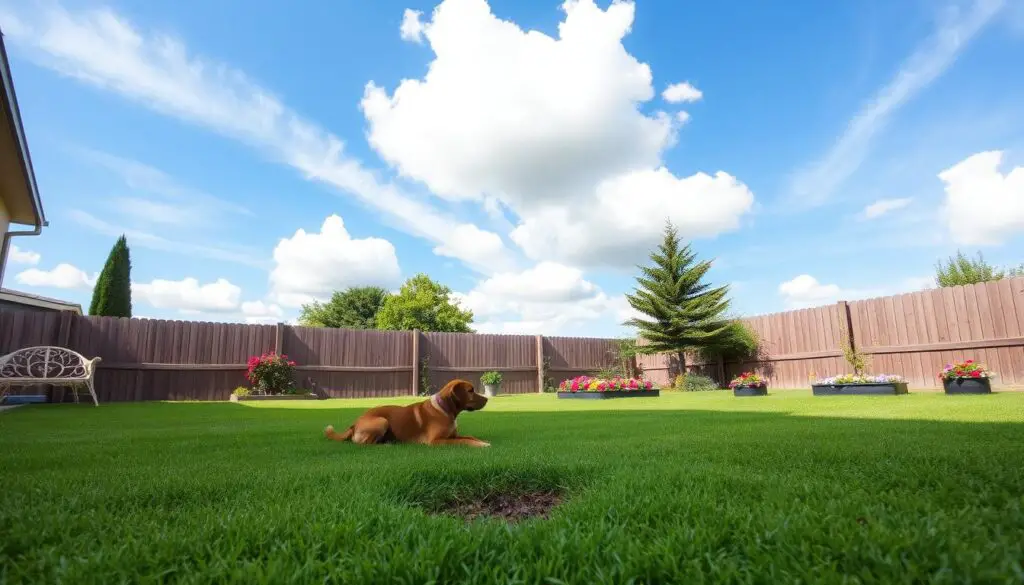
Lawn Care for Pet Owners
As a pet owner, it’s key to have a green and safe lawn for your pets. Lawn care tips for pet owners are more than just mowing and watering. It’s important to keep your pets in mind and use safe lawn care practices.
Choosing the right grass is crucial for a pet-friendly yard. Grass types like tall fescue, Kentucky bluegrass, and zoysiagrass are great. They can handle the wear and tear from pets.
| Grass Type | Durability | Resistance to Pet Damage |
|---|---|---|
| Tall Fescue | High | Excellent |
| Kentucky Bluegrass | Moderate | Good |
| Perennial Ryegrass | High | Excellent |
| Bermudagrass | High | Excellent |
| Zoysiagrass | High | Excellent |
For dog-safe lawn maintenance, clean up pet waste right away. Dilute areas where dogs pee to avoid lawn damage. Keeping the lawn tall helps the roots grow strong and holds moisture.
Adding pet-friendly features like hardscapes and mulch helps. It creates safe spots for pets to play and go to the bathroom. Maintaining a pet-friendly yard is a lot of work, but it’s worth it for your pets’ happiness.
Mow Grass at Optimal Height
As a pet owner, keeping your lawn healthy is key. Mowing your grass at the ideal height for pet-friendly lawns is crucial. Letting your grass grow taller can greatly benefit your pets.
Taller grass, over 3 inches, has deeper roots. This makes it stronger against your pets’ playtime damage. It also helps conceal pet damage and camouflage any brown spots from their play. By using the right mowing techniques, you can keep a lush, pet-friendly lawn that lasts.
Optimal Mowing Height for Different Grass Types
The best mowing height for your lawn depends on the grass type. Here are some guidelines:
- Tall fescue: 3-4 inches
- Kentucky bluegrass: 2.5-3.5 inches
- Perennial ryegrass: 2-3 inches
- Bermudagrass: 1-2 inches
- Zoysiagrass: 1-2 inches
Mowing at the higher end of these ranges creates a lush, resilient surface. This surface can better handle pet wear and tear. It keeps your pets happy and your lawn healthy all year.
“Taller grass means deeper roots, and deeper roots mean a hardier lawn.”
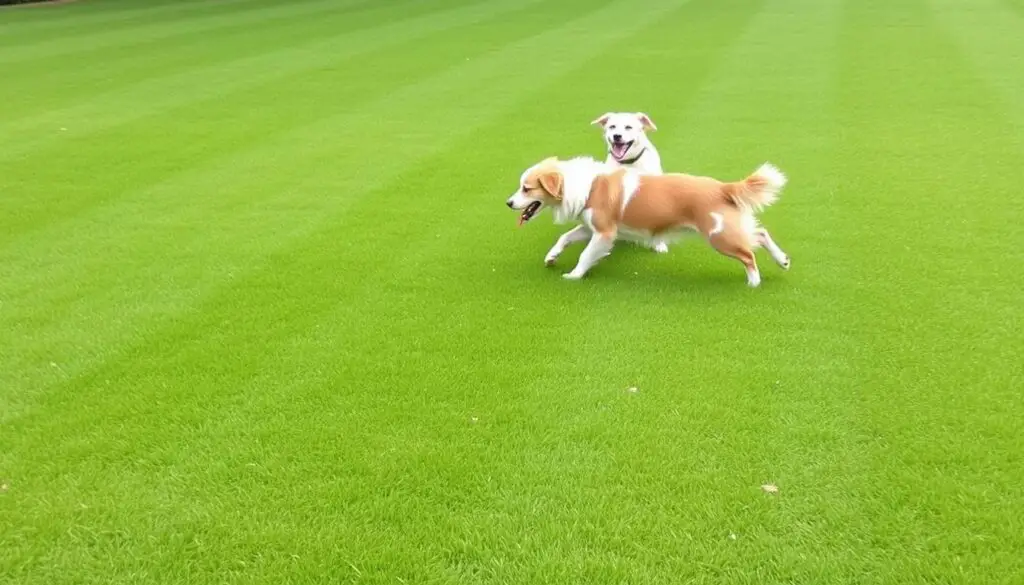
Fertilize Mindfully
As a pet owner, it’s important to fertilize your lawn carefully. Many lawn fertilizers have too much nitrogen. This can harm your grass and make it look bad.
Look for pet-safe lawn fertilization options with less nitrogen. Choose organic or natural treatments that are safe for pets and the environment. These products have lower nitrogen levels, which helps avoid damage from both fertilizer and dog waste.
For how often to fertilize, talk to lawn care experts. They can suggest the best schedule and products for your lawn. This way, you can keep your lawn healthy without over-fertilizing. By reducing nitrogen in fertilizers for dog owners, you make your outdoor space safer for everyone.
| Fertilizer Brand | Nitrogen Content | Pet-Safe | Organic |
|---|---|---|---|
| Safer Brand Lawn Restore | 4-4-4 | Yes | Yes |
| Espoma Organic Lawn Food | 9-0-0 | Yes | Yes |
| Milorganite Organic Fertilizer | 6-4-0 | Yes | Yes |
| Scott’s Natural Lawn Food | 8-0-0 | Yes | Yes |
By choosing the right pet-safe lawn fertilization products and adjusting your schedule, you can have a healthy lawn. It’s safe for your pets to play on. Remember, being mindful is key to a happy lawn and pets.
Identify and Treat Yellow Spots Early
As a pet owner, watching your lawn closely is key. Look out for yellow spots where your dog likes to hang out. These spots might turn brown if not treated soon.
Dog urine contains urea, a nitrogen-rich compound. This can harm your grass, making it yellow and weak. It’s vital to act fast to prevent more damage.
Flushing and Treating the Affected Areas
Start by flushing the yellow spots with water. This helps lower the nitrogen and salt levels. After flushing, use a special treatment for pet lawn issues.
Products like NaturVet GrassSaver Chews and Dog Rocks can help. They balance your dog’s urine pH. Treatments like Revive Dog Spot Treatment can fix brown spots from pet urine.
Acting early can save your grass. Regular lawn care helps too. It makes your grass stronger against pet damage.
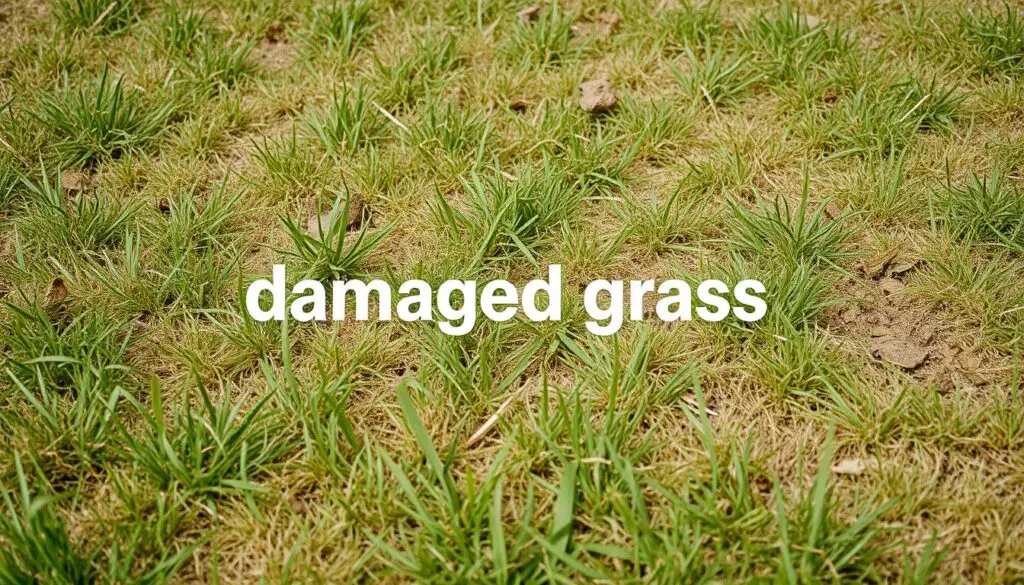
Identifying and treating yellow spots quickly is crucial. With the right care and products, your lawn can stay green and healthy. Even with a pet around.
Incorporate Pet-Friendly Landscaping
If you own a pet, making your yard dog-safe can change everything. Instead of letting your pet run wild and damage your grass, use hardscapes, mulch, and ground covers. These can mark off areas for your pet to play and explore.
Hardscapes and Mulch for Pet-Designated Zones
Paving stones, concrete, or smooth gravel can make a special path or patio for your dog. Mulch, like rubber nuggets or cedar chips, is also great. It’s tough and easy to keep up. These options help keep your lawn safe while giving your pets a place to play.
Low-Maintenance Ground Covers
Looking for something other than grass? Try snow-in-summer, creeping thyme, or Irish moss. These plants are tough and don’t need much care. They’re soft for your pets and make your yard look good too.
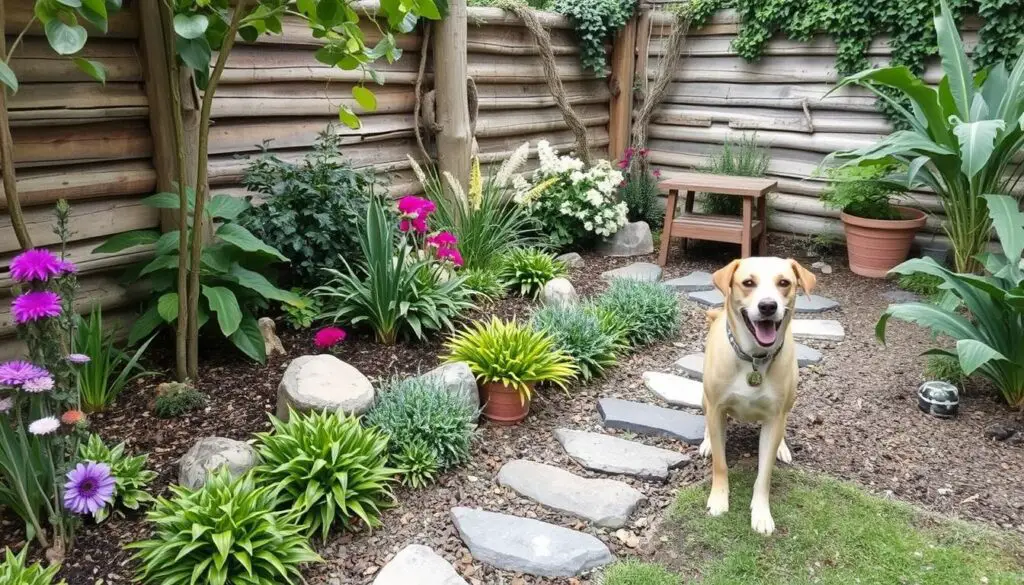
Adding these pet-friendly features to your yard makes a big difference. You get a beautiful outdoor space and a happy, active pet. It’s a win-win for everyone.
Practice Flea Prevention
Fleas can be a big problem in yards where pets live. But, you can stop them before they start. By using natural ways to keep fleas away, you can keep your pets and yard healthy.
Keeping your lawn clean is key to stopping fleas. Mow the grass regularly and pick up any trash. This stops fleas from having places to live. Also, don’t water too much and don’t dethatch the lawn. This makes it harder for fleas to survive.
Using cedar chip mulch is another good idea. The smell of cedar keeps fleas away. It’s a natural way to protect your yard from fleas.
If you think you have fleas, act fast. Keep trash cans closed to keep wildlife away. Use safe pesticides like Bayer Advanced Complete Insect Killer. With care and these steps, you can keep your yard and pets flea-free.
| Flea Control Product | Effectiveness |
|---|---|
| Capstar | Kills adult fleas within 24 hours |
| Comfortis | Kills adult fleas within 30 minutes and remains effective for 30 days |
| Frontline Plus | Kills adult fleas, flea larvae, and flea eggs on cats and dogs |
| Promeris | Provides up to 7 weeks of flea control in cats and protects against reinfestation |
| Revolution | Kills adult fleas and prevents flea eggs from hatching for one month |
By taking steps to prevent fleas, you can protect your yard and pets. With some effort and the right lawn care, you can have a flea-free outdoor space for many years.
Use Organic, Pet-Safe Lawn Treatments
As a pet owner, you want to keep your furry friend safe and your lawn healthy. Many lawn care products have harsh chemicals that can harm dogs. It’s important to choose organic, pet-safe options for fertilizing, weed control, and pest management.
Conventional lawn treatments can be toxic to dogs. They can make your dog very sick if they eat them. These chemicals have been linked to cancer in dogs. Instead, use natural, pet-friendly solutions that are safe for your pet.
- Choose organic fertilizers that are free from harmful chemicals, such as Scotts Natural Lawn Food, Espoma Organic Lawn Food, or Purely Organic Lawn Food.
- Explore eco-friendly weed control methods, like hand-pulling weeds or applying corn gluten meal, which prevents weed seeds from germinating.
- Opt for natural pest management strategies, such as introducing beneficial insects or using essential oils, to keep pests at bay without exposing your pet to toxic substances.
Switching to organic, pet-safe lawn treatments keeps your yard beautiful and your pet safe. Always follow product guidelines and wait before letting pets on treated areas. Watch your dog for any signs of distress. With care, you can have a lush, chemical-free lawn that’s safe for pets.
| Lawn Treatment | Pet-Safe Alternative | Key Benefits |
|---|---|---|
| Conventional Fertilizers | Organic Lawn Food |
|
| Chemical Weed Killers | Corn Gluten Meal |
|
| Synthetic Pesticides | Essential Oils & Beneficial Insects |
|
If your pet shows signs of distress after being near lawn treatments, even if they’re labeled “pet-safe,” talk to a vet. By choosing chemical-free, eco-friendly lawn care, you can create a safe space for your pet.
Remove Foxtail Weeds
As a pet owner, it’s important to watch out for foxtail weeds in your lawn. These weeds can harm your pets if not removed. Foxtails, or grass seed awns, are annual summer grasses that can attach to dogs’ bodies. This can lead to painful infections and serious health issues if they get into vital organs.
Foxtails are common in the Western United States. They thrive in places like hiking trails, parks, and open fields. If your dog shows signs like head shaking or limping, it might have foxtails. Early removal is key, as severe cases might need surgery.
To keep your lawn safe for pets, remove foxtail grass quickly. Start by mowing the weeds before they seed. But, you must keep watching and removing them. Digging out the whole plant is a good way to stop them from spreading.
If digging is hard, try natural weed control methods. Use organic herbicides like ammonium nonanoate or corn gluten-based products. These are safe for pets and can stop foxtails from growing.
By actively removing foxtail weeds, you can keep your lawn safe for pets. Stay alert and seek vet help if you think your dog has foxtail issues.
| Foxtail Weed Facts | Key Considerations |
|---|---|
|
|
“Prevention is key when it comes to protecting your pets from the dangers of foxtail weeds. Stay vigilant, and take swift action to eliminate these hazardous grasses from your lawn.”
Avoid Toxic Plants
Creating a pet-friendly outdoor space means being careful with plants. Many garden plants can harm our pets if they eat them. Before adding new plants, I check the ASPCA’s list of safe and toxic plants for pets.
Plants like Easter Lilies, Poinsettias, American Holly, and Alocasia are dangerous for dogs. Even a little bit can cause serious health problems. To keep my pets safe, I make sure these plants are out of reach.
I choose safe plants like Rosemary, Hibiscus, Blue daisy, Sage, and Sunflower. These plants are not only safe but also add beauty to my yard. Keeping a safe outdoor space for pets is very important. Knowing which plants are toxic is key to keeping my dogs safe.

